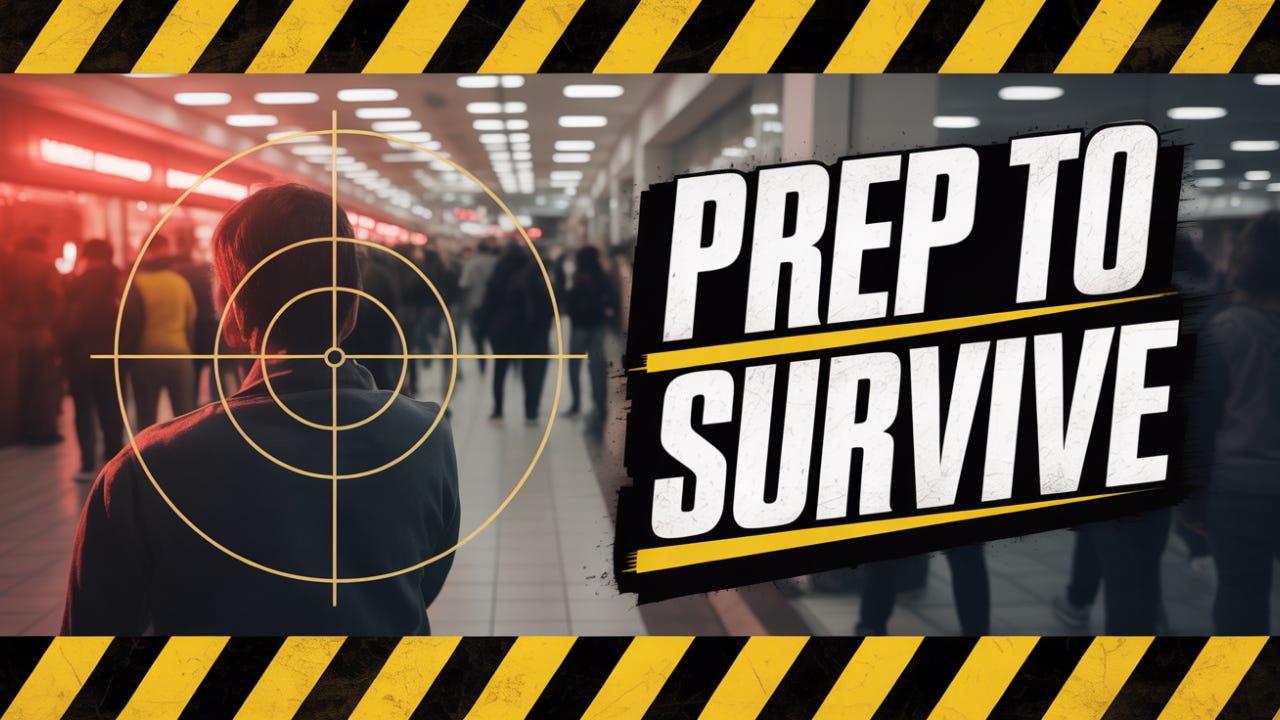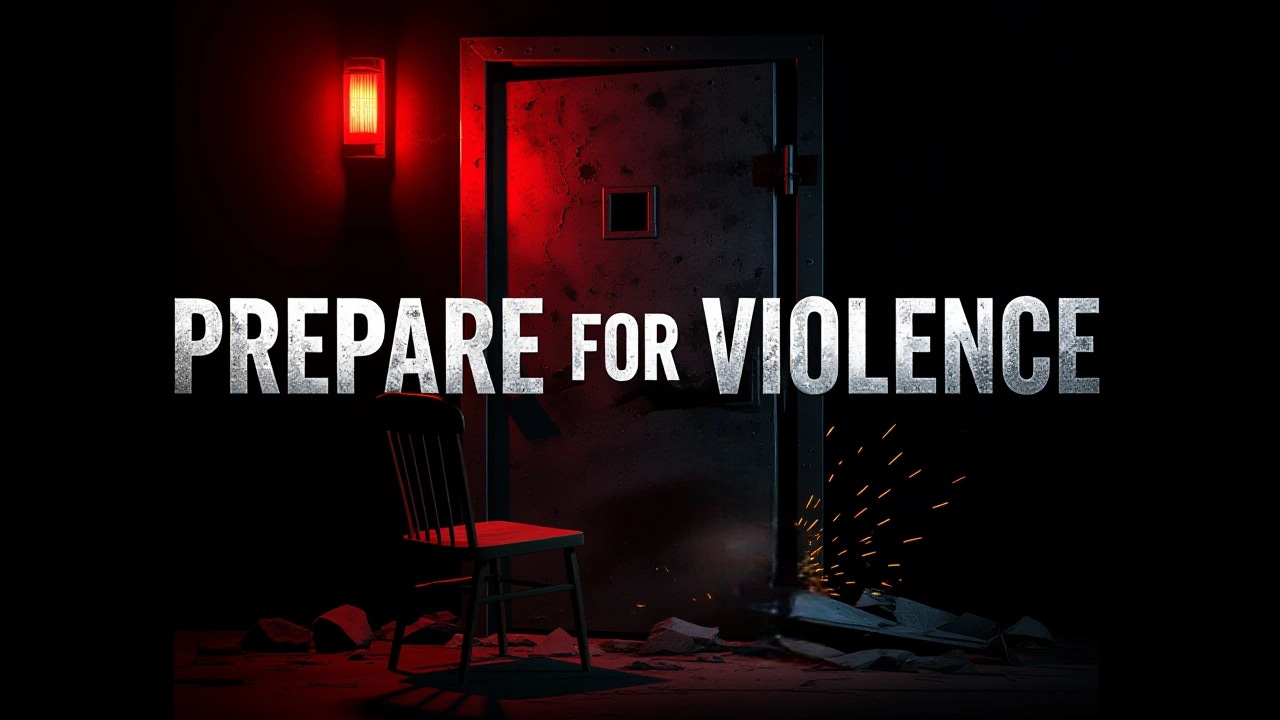Surviving & Preparing for Sudden Violence
A comprehensive guide, plus downloads
Introduction
In today's world, the threat of sudden violence, whether from riots, terrorist attacks, or active shooters, is a reality that everyone should be prepared for. This guide provides a comprehensive approach to improving your chances of survival and preparing yourself for such events. The guide is divided into two main sections: strategies for surviving sudden violence and steps for preparing yourself for potential threats.
Surviving Sudden Violence
1. Situational Awareness
Always be aware of your surroundings. Notice exits, potential hiding spots, and any unusual behavior or activities. Avoid distractions like excessive use of headphones or being engrossed in your phone. Stay alert to anything that seems suspicious, such as a person’s behavior, unclaimed packages, unusual activity, and vehicles. Situational awareness is your first line of defense and can help you react quickly if a threat arises. For example, if you notice someone acting strangely or see an unattended bag, trust your instincts and move to a safer location.
2. Have an Escape Plan
Familiarize yourself with the layout of buildings and public spaces you frequent. Know where the exits are and have a mental map of escape routes. In the event of a riot or active shooter, your primary goal should be to escape if it is safe to do so. Practice different escape routes and know alternative exits in case your primary route is blocked. For instance, if you are in a mall, know where the emergency exits are located and how to get to them quickly.
3. Stay Calm
Panic can cloud judgment and slow down your reaction time. Practice staying calm under pressure through techniques like deep breathing or mental rehearsals. The “OODA Loop” (Observe, Orient, Decide, Act) is a useful framework to stay calm and make decisions during high-stress situations. This loop helps you process information quickly and act decisively. For example, if you hear gunshots, quickly observe your surroundings, orient yourself to the nearest exit, decide on the best course of action, and act accordingly.
4. Know Basic First Aid
Learn basic first aid skills to treat injuries, including how to stop bleeding, perform CPR, and treat shock. Consider taking a first aid course to gain hands-on experience. Knowing how to administer first aid can save lives, including your own, in the event of an injury. For instance, if someone is bleeding heavily, apply pressure to the wound and elevate the injured area to help stop the bleeding.
5. Carry Essential Items
Keep a small emergency kit with you, including items like a compact first aid kit, a whistle to signal for help, and a multi-tool. In some situations, a small flashlight can also be useful. These items can be crucial in helping you navigate and signal for help during an emergency. For example, a whistle can be used to attract attention if you are trapped or injured.
6. Avoid Crowded Areas
If possible, avoid large crowds or high-risk areas, especially during times of heightened tension or known threats. If you must be in a crowded place, stay near the edges where you can move more easily. Crowded areas can be difficult to escape from quickly, making them more dangerous in the event of sudden violence. For instance, if you are at a concert, try to stay near the exits and be aware of your surroundings.
7. Communicate with Others
Let someone know your plans and where you will be. In case of an emergency, they can alert authorities or provide information about your last known location. Regular communication with trusted contacts can help ensure that someone is aware of your situation and can take action if needed. For example, if you are going to a new place, send a quick message to a friend or family member with your location and expected return time.
8. Learn Self-Defense
Basic self-defense training can help you protect yourself if escape is not an option. Focus on techniques that are practical and can be used in real-life situations. Self-defense training can boost your confidence and prepare you to act quickly if necessary. For instance, learning how to break free from a grab or how to strike vulnerable areas can be crucial in a self-defense situation.
9. Follow Official Instructions
In the event of an emergency, follow the instructions of law enforcement, emergency responders, or official announcements. They have the training and information to guide you to safety. Trusting the expertise of professionals can help you make the right decisions during a crisis. For example, if authorities advise you to shelter in place, follow their instructions and stay calm.
10. Stay Informed
Keep up-to-date with local news and emergency alerts. Sign up for emergency notification systems in your area to receive real-time information about potential threats or ongoing incidents. Staying informed can help you anticipate and avoid dangerous situations. For instance, if there is a report of a nearby riot, you can adjust your plans to avoid the area.
Preparing for Sudden Violence
1. Understand the Threat
Educate yourself about the types of violence that can occur in your area. This includes understanding the political, social, and economic factors that can lead to civil unrest or terrorist attacks. Knowledge of potential threats can help you prepare more effectively. For example, if your area has a history of political protests, be aware of upcoming events and plan accordingly.
2. Secure Your Home
Make your home a hard target by installing security measures such as locks, alarms, and reinforced doors. Consider setting up a safe room inside your home where you and your family can retreat if intruders enter or violence is directly outside. Home security can deter potential threats and provide a safe haven during emergencies. For instance, installing a security system can alert you to any unauthorized entry and provide a deterrent to potential intruders.
3. Stock Up on Supplies
Have an emergency supply kit that includes food, water, medical supplies, and other essentials. Ensure that your kit is easily accessible and that all family members know where it is located. An emergency supply kit can sustain you and your family during a crisis. For example, include items like non-perishable food, water purification tablets, a first aid kit, and a portable radio.
4. Develop a Family Emergency Plan
Create a plan that includes evacuation routes, meeting points, and communication methods. Practice this plan regularly with your family to ensure everyone knows what to do in case of an emergency. A well-rehearsed emergency plan can save lives and reduce panic. For instance, designate a meeting point outside your home in case of a fire or other emergency.
5. Learn Survival Skills
Acquire skills such as first aid, basic self-defense, and how to use emergency equipment. These skills can be crucial in surviving sudden violence. Survival skills can empower you to act decisively and effectively during a crisis. For example, learning how to use a fire extinguisher can help you put out small fires before they spread.
6. Stay Connected
Maintain communication with local authorities and emergency services. Sign up for community alert systems and stay informed about any potential threats in your area. Staying connected can help you receive timely warnings and instructions. For instance, signing up for local emergency alerts can provide you with real-time information about potential threats.
7. Be Prepared to Evacuate
Know the evacuation routes in your area and have a plan for where you will go if you need to leave your home quickly. Keep important documents and valuables in a safe place that you can grab quickly. Being prepared to evacuate can help you act quickly and safely during an emergency. For example, have a go-bag ready with essential items like identification, medication, and important documents.
8. Train Your Family
Ensure that all family members are aware of the emergency plan and know what to do in case of sudden violence. Conduct regular drills to practice evacuation and shelter-in-place procedures. Family training can ensure that everyone is prepared and knows how to respond during a crisis. For instance, practice fire drills to ensure everyone knows how to exit the home safely.
9. Monitor Political and Social Developments
Stay informed about political, social, and economic developments in your region. Reliable intelligence sources and tools can provide real-time updates to keep you informed. Monitoring developments can help you anticipate and prepare for potential threats. For example, following local news and social media can provide insights into potential areas of unrest.
10. Foster a Sense of Community
Build strong relationships with your neighbors and community. A supportive community can be a valuable resource in times of crisis and can help you stay safe during sudden violence. Community support can provide additional eyes and ears to detect potential threats and offer assistance during emergencies. For instance, joining a neighborhood watch program can enhance community safety and preparedness.
Conclusion
Preparing for and surviving sudden violence requires a combination of awareness, planning, and quick decision-making. By following the strategies outlined in this guide, you can significantly improve your chances of staying safe during riots, terrorist attacks, or active shooter situations. Stay informed, stay prepared, and stay safe.
There are multiple dowloads for GUARDIAN members below my signature.
Godspeed,
Chris Heaven, CEO
Survival Dispatch
Keep reading with a 7-day free trial
Subscribe to Survival Dispatch News to keep reading this post and get 7 days of free access to the full post archives.









